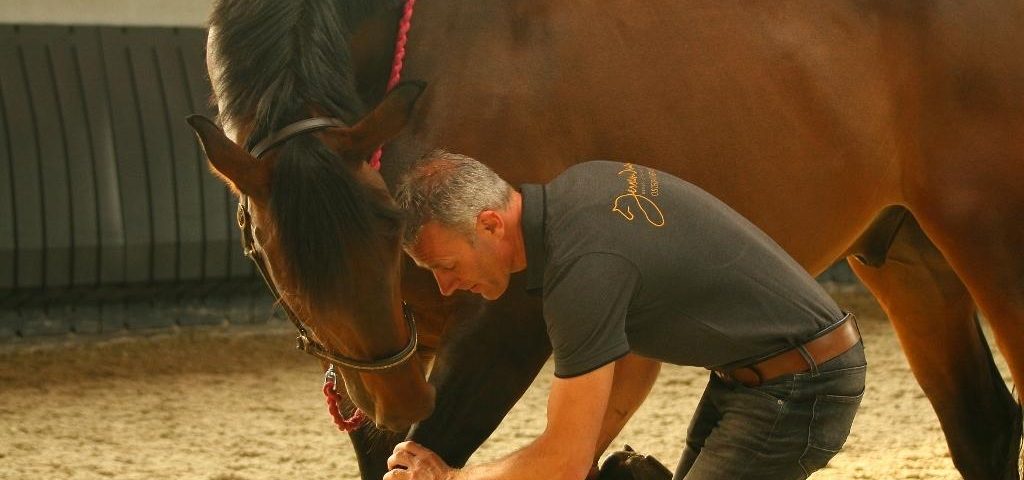An athletic horse or a strong horse? What are your training goals?
An athletic horse or a strong horse? What are your training goals?
An athletic horse or a strong horse? What are your training goals?
There is a lid for every pot…
As an equine osteopath, I travel to all sorts of different places, from small, private yards to large, professional stables. I see lots of different horses, small and large, rotund and thin, dressage horses, showjumpers and horses that are kept simply for recreational purposes. One thing applies in every case, though, regardless of the reason why an owner keeps a horse: they all want the best for their animal.
I often hear an owner say: ‘I want my horse to get stronger!’ As a professional osteopath, I find myself wondering whether the person in question knows the difference between an ‘athletic’ horse and a ‘strong’ horse, and whether they realize the effect that this difference has on the way in which they train their horses. Let me explain.
Left-handed or right-handed
Every time I see a new horse, I always begin by looking at their front-end conformation. I want to find out whether they are left-handed or right-handed. This is sometimes difficult to see. The front hoof on a horse’s ‘preferred side’ has a somewhat rounder and flatter shape. This hoof usually bears more weight, giving it a slightly ‘flatter’ look than the hoof on the ‘non-preferred side’, which often has a steeper angle. A horse’s preferred side often also has better blood circulation. Take a critical look at your own horse. What does their body look like?
Like humans, horses can be either left-handed or right-handed and also have a preferred side. Knowing whether you have a left-handed or right-handed horse is enormously important. I cannot stress this strongly enough. If you, as their rider, know whether your horse is left-handed or right-handed, and if you are aware of your horse’s build, you will be able to improve the focus of your training. If you know their natural ‘preferred side’, you can make your horse more agile and athletic without overtaxing them, and structure your training plan based on what you know.
If a horse is left-handed, they will find it easier to perform training exercises on the left lead. You will encounter more resistance on the right lead, but if you know that this is their more difficult side, you can use this knowledge in your training. Breaking exercises down into smaller chunks, riding the right gymnastic exercises, and avoiding frustration: these are all crucially important elements in your training plan. Do this right and your horse will become stronger on their weaker side.
Cause and effect
Crookedness often results in physical blockages. If I come across tightness or blockages in a horse, I will start treatment and see what I find. If in doubt, I will always refer you to a vet. In many cases, horses’ bodies are more than capable of resolving problems on their own, but sometimes they need a bit of help. Basically, this help – my treatment – consists of both a mental and a physical component. I try and resolve blockages, and most importantly, I explain to the owner how the blockages came into being.
If a horse resists or refuses due to physical discomfort, I want to know where this comes from. I go in search of the cause, and this allows me to help the owner. I am happy to give you tips and advice on how to continue your training. It’s up to you to do what you like with my advice, as long as you remember that horses want to do the right thing. If they didn’t, they would lie down at the back of the stable and not come out any more. A horse that resists or refuses often has genuine physical issues.
Fine-tuning your training
If you tune your training to your horse’s needs, you will build agility and resilience, rather than just strength. The fact is that an agile, athletic horse can become stronger, but a strong horse doesn’t necessarily become more athletic. Strong horses may overcompensate because they are crooked to one side. This means that they will try and make themselves stronger, but in the wrong way. You will be training the wrong muscles, or overtaxing their muscles and body to such an extent that you may cause blockages or even injuries. What you really need to do is to view your training as a form of ‘adaptive education’ or customized learning. Just as a school teacher will try and adapt their teaching materials to the needs of their students, so you too should try and adapt your training to your horse’s needs.
By fine-tuning your training, you will create training sessions that both you and your horse will enjoy, as you’ll be training at a level that suits you both. Most likely, you’ll be able to enjoy your horse for a longer period of time as the correct training will prolong their lifespan, reduce the number of injuries and boost their work ethic. A horse that becomes frustrated, will resist, overcompensate or shut down. If this happens, you will soon find out just how small and weak you are when compared with 600-odd kilos of horsepower. In other words, it’s best to keep on the right side of your horse. 😉


